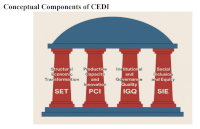Beyond HDI and Per Capita Income: Constructing a Composite Economic Development Index (CEDI) for a Multi dimensional Assessment
Main Article Content
Abstract
The measurement of economic development remains central to both academic inquiry and policy formulation. Traditional indicators such as Per Capita Income (PCI) and the Human Development Index (HDI) have long dominated development discourse, yet their limitations—ranging from mono-dimensionality to insensitivity to institutional and structural change—have increasingly constrained their utility. This paper introduces the Composite Economic Development Index (CEDI), a novel, multidimensional framework that captures the complex, interrelated drivers of sustainable economic progress. Unlike PCI, which reflects only in come averages, and HDI, which narrowly aggregates education, income, and life expectancy, the CEDI encompasses six core dimensions: Economic Structure and Diversification; Institutional and Governance Quality; Human Capital and Health; Technological Readiness and Innovation; Environmental Sustainability; and Employment and Labour Market Inclusion. The construction of the CEDI employs Principal Component Analysis (PCA) to derive empirically grounded weights, thereby addressing methodological shortcomings in existing indices. By integrating structural transformation, productive capacity, institutional integrity, and inclusion, the CEDI provides a more comprehensive and diagnostic measure of development. The paper argues for the superiority of CEDI over HDI and PCI based on its multidimensional depth, structural and institutional sensitivity, balance and equity considerations, and enhanced policy relevance. The CEDI not only captures current outcomes but also the underlying conditions that determine a nation’s long-term development trajectory. Its adaptability and diagnostic accuracy make it particularly valuable for developing countries, where traditional indicators frequently mask critical dimensions of development. The study concludes by recommending the adoption of CEDI by national governments and international agencies as a superior benchmarking and planning tool in the pursuit of inclusive, resilient, and sustainable economic development.
Downloads
Article Details
Section

This work is licensed under a Creative Commons Attribution-NonCommercial 4.0 International License.
Share
References
1. Acemoglu, D., & Robinson, J. A. (2012). Why nations fail: The origins of power, prosperity, and poverty. Crown Business.
2. Anand, S., & Sen, A. (2000). Human development and economic sustainability. World Development, 28(12), 2029–2049. https://doi.org/10.1016/S0305-750X(00)00071-1
3. Cadot, O., Carrère, C., & Strauss-Kahn, V. (2011). Export diversification: What's behind the hump? The Review of Economics and Statistics, 93(2), 590–605.
4. International Energy Agency. (2021). World energy outlook 2021. https://www.iea.org
5. Kanbur, R., & Stiglitz, J. E. (2016). Sustainable development goals and measurement of economic and social progress. Commission on Global Poverty.
6. Kaufmann, D., Kraay, A., & Mastruzzi, M. (2010). The worldwide governance indicators: Methodology and analytical issues. World Bank Policy Research Working Paper No. 5430.
7. Klugman, J., Rodríguez, F., & Choi, H.-J. (2011). The HDI 2010: New controversies, old critiques. Journal of Economic Inequality, 9(2), 249–288. https://doi.org/10.1007/s10888-011-9178-z
8. North, D. C. (1990). Institutions, institutional change and economic performance. Cambridge University Press.
9. Organisation for Economic Co-operation and Development. (2015). In it together: Why less inequality benefits all. OECD Publishing.
10. Organisation for Economic Co-operation and Development. (2020). Main science and technology indicators. https://www.oecd.org/sti/msti.htm
11. Prebisch, R. (1950s). The economic development of Latin America and its principal problems. United Nations/ECLAC.
12. Rodrik, D. (2007). One economics, many recipes: Globalization, institutions, and economic growth. Princeton University Press.
13. Rodrik, D. (2008). Second-best institutions. American Economic Review, 98(2), 100–104. https://doi.org/10.1257/aer.98.2.100
14. Sala-i-Martin, X., & Subramanian, A. (2013). Addressing the natural resource curse: An illustration from Nigeria. Journal of African Economies, 22(4), 570–615. https://doi.org/10.1093/jae/ejt006
15. Sen, A. (1999). Development as freedom. Oxford University Press.
16. Stiglitz, J. E., Sen, A., & Fitoussi, J.-P. (2009). Report by the Commission on the Measurement of Economic Performance and Social Progress. https://www.stiglitz-sen-fitoussi.fr
17. Todaro, M. P., & Smith, S. C. (2020). Economic development (13th ed.). Pearson.
18. United Nations Development Programme. (1990). Human development report 1990: Concept and measurement of human development. UNDP.
19. World Bank. (2022). World development indicators. https://databank.worldbank.org
20. World Intellectual Property Organization. (2021). World intellectual property indicators 2021. WIPO.
21. World Intellectual Property Organization. (n.d.). Global innovation index. https://www.wipo.int/global_innovation_index


